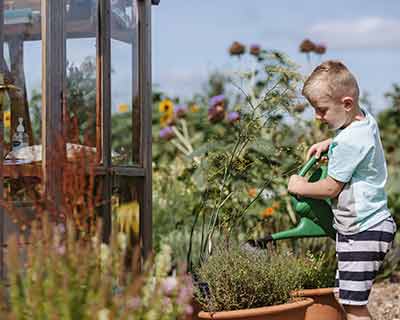Creating a child-friendly garden design
Inspiring ideas to get children started on a lifelong adventure with gardening, with expert advice from landscape architects Adam White and Andrée Davies
Creating a garden that is safe and enjoyable for children of all ages is easier than you might think. Regardless of whether you have young kids, teenagers, frequent child visitors or grandchildren, you can have a stunning garden without necessarily including a single piece of play equipment.
Five tips for designing a child-friendly garden
1. Space to move - Let's start with the trickiest in terms of size. You don’t need a huge lawn, even a tiny space can have pathways and destinations, or even something to climb. Circular, winding paths take up little space and you can use mown paths or recycled materials for unique textures underfoot. Get those little limbs moving by placing chunky logs for them to cross an imaginary ravine, or hang a ladder in a tree for them to climb. If your space doesn't allow for either of these, remember that local parks and RHS Gardens are available to you all year round.
2. Space to hide – It’s natural to want to hide away sometimes, so think about how this might evolve as a child grows. For toddlers, the hiding spot should be visible to adults but feel hidden for the child, to have that sense of adventure and exploration. A den or tree house is the dream for most young children, but even a simple canopy tent over a cane, or a platform tucked behind a tree can work well. For teenagers, it’s important to create somewhere that provides some privacy, a cosy nook to read, and a place to hang out with friends away from adults. Adding plants which screen can make an area feel hidden from the outside world, allowing for imaginative play where children can pretend they are giants or fairies.
3. Space to share – It’s important to create a shared space outdoors where everyone can come together after spending time in their own individual spaces. This could be a dining space or simply a corner with a few logs around a fire. Let your family help you decorate the space, choosing outdoor cushions, basic bunting, candles in jars, and simple flower arrangements picked from the garden to make it special.
4. Space to learn - A blackboard or covered sand tray makes the perfect easel, while natural items like sticks and stones make great brushes. As the child grows, foster their creativity by providing them with a space to dig, containers to plant, or a shed to decorate in their unique style. It’s a great idea to introduce them to planting from a young age, as it helps engage them with the world around them. Watching something grow and nurturing it to its full potential is an invaluable learning experience.
The RHS Campaign for School Gardening has a wealth of free resources to help children learn through growing. Learning about plants helps children understand where food comes from, and gives them space to be creative.
5. Space to discover - Giving children opportunities to safely explore the world around them builds confidence, resilience and improves their immune system. When children get their hands in the soil, there is evidence that exposure to natural non-pathogenic microbes 'teaches' their bodies how to defend themselves. It’s important to allow them time to observe the wildlife around them, such as the creatures in the pond, insects in the long grass, butterflies on the shrubs, and bees in the flowers.
What the experts say
Leading landscape architects Adam White and Andrée Davies have created some of the most innovative and engaging play spaces around the UK and co-designed the RHS Back to Nature Gardens with the Princess of Wales in 2019.
Adam and Andrée believe that successful playful gardens...
• are bespoke,
• are well located,
• make use of natural elements,
• provide a wide range of play experiences,
• are accessible to both disabled and non-disabled children,
• meet the families needs,
• allow children of different ages to play together,
• build in opportunities to experience risk and challenge,
• are sustainable and appropriately maintained,
• allow for change and evolution.
Inspiration from the RHS Back To Nature Gardens
Read the latest Government survey on how children and young people experience and think about the natural environment: The Children’s People and Nature Survey for England: 2022 update



